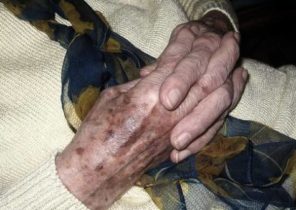
Hot water or cold? With soap or liquid hand wash? Towel or dryer? Almost a ritual after using the toilet — how to do it the best way? The correspondent of BBC Future is looking for the best way.
Now let’s wash hands! Sounds simple? But, as often happens, behind the apparent simplicity lies a lot of options and problems, which we do not suspect.
Although there is a lot of evidence that hand washing after visiting the toilet, before eating or after a trip on public transport greatly reduces the likelihood of disease, only 5% of us always wash their hands when and how it should be.
The study of the behavior of more than 3 thousand people showed that 10% of them leave the public toilet, not washing their hands, and of those who do, 33% did not use soap.
And it matters because we usually inadvertently touch hands, face, nose, lip, thus allowing the microbes to penetrate effortlessly in our body.
Researchers in Brazil and the US have discovered that we touch various surfaces in public areas an average of 3.3 times per hour. And his nose and lips we touch approximately 3.6 times per hour.
It is clear that we need to wash hands. The problem is that there are many myths about how to do it.
Should the water be hot?
During the study, which involved 500 American adults, 69% of them expressed the view that water temperature influences the effectiveness of hand washing.
That high temperature can kill the bacteria — it’s true. That’s why some types of food we prepare, by applying such a temperature.
However, to kill bacteria on your hands, the water should be hot, boiling water.
Salmonella, for example, can survive for more than 10 minutes at a temperature of 55 degrees Celsius. If you try to wash your hands in water heated above this temperature, you risk to get burned in the first thirty seconds.
Researchers from Florida to find out how many germs remain on our hands after washing in water, the temperature of which is between 4.4 and 50 degrees Celsius, used the following method.
First, the volunteers rubbed the hands of the so-called bacterial soup or raw ground beef. Then they washed their hands in water a certain temperature and put on rubber gloves. After that, gloves were filled with a special solution.
After a minute, during which the hands through the gloves massaged to all of the bacteria mixed with the solution, the resulting liquid (“glove juice”) was sent to the lab.
It was found that whatever the temperature of the water, it almost did not affect the number of bacteria remaining on the hands.
However, let’s not jump to off the hot water in public toilets. Don’t forget about the quirks of human behavior.
In these experiments, hand washing occurred on the stopwatch, while in real life, if the water is too cold or too hot, we shorten the wash time.
Quickly rinse your hands under the tap is not enough, but the warm water of a comfortable temperature can make us to spend more time at the sink.
Are there advantages of antibacterial soap?
On this issue, spent quite a lot of research. For example, in 2007, scientists have collected the results of several works and concluded that a component, often at the time you add in antibacterial soap (triclosan), reduced the number of bacteria remaining on the hands after washing, no more than ordinary soap.
No different from a regular antibacterial soap in preventing infection, any infection.
A recent analysis of more recent studies carried out in 2015, gave the same results.
Meanwhile, the results of several laboratory studies have shown that triclosan may contribute to bacterial resistance to antibiotics and cause hormone disruption in animals. As a result, in the US and the EU countries banned add triclosan in consumer products.
So the best option is ordinary soap and water the temperature that you like.
Then do I need to wipe or dry their hands?
When you are in a hurry, it’s tempting not to wipe his hands — and that’ll dry themselves! Well, it’s okay if the path from the toilet you don’t touch.
If you still are touching something — such as doorknobs — you are on the way collecting germs because they damp your hands just a gift.
No wiping and no drying of hands, you are missing the chance to reduce the number of germs that remain on your palms and fingers even after thorough washing.
Dryer or paper towel?
For this reason opinions differ. In most studies, the palm is given to disposable paper towels.
In the end, to wipe his hands with a towel is much faster than to wait for the jet of air will do the trick.
According to one new Zealand study (it is worth noting, however, that it was funded by the service providing toilets with paper towels), people spend 45 seconds to dry your hands under a stream of air. It is clear that most of us don’t want to wait that long.
However, high-speed dryers of the new generation are much faster. As quickly and efficiently as paper towels: 10 seconds — and hands are completely dry.
However, high-speed dryers got its share of criticism: the air stream is so powerful that germs just fly around.
A study of the University of Westminster has shown that the most powerful high-speed dryer is able to send a virus to one and a half meters. Then another study increased that figure to as much as three meters.
Whether to believe these results — you decide. After all, most of the studies funded by those who sell paper towels. However, the authors frankly admitted this, and the results were published in peer-reviewed journals.
In this situation much more sense in studies conducted in the public toilets and not in the laboratory. In addition, it would be nice to take into account our preferences.
In the end, any method that encourages people to wipe/dry hands after washing them is already a step forward.
Much depends on toilets. In a study conducted in one of the University cities in the U.S., involved more than 3 thousand people. It showed that if the toilet is clean, thoroughly cleaned, then the person is much more likely to properly wash my hands.
When the sinks were dirty, the study participants simply wanted to leave.
Born in the forest herringbone
No matter what method of hand washing you choose, the main thing — wash them longer than you’re used to. How should lather them — not only palms but also the outer surface of the hands, RUB between your fingers, pay attention to what you have under the fingernails, and the space that is closer to the wrists.
All this should take 15 to 30 seconds, no less. To ensure that you wash your hands long enough, try to sing to himself a few bars of “In the forest tree was born”.
But if in a public toilet no one — and in a loud voice.







